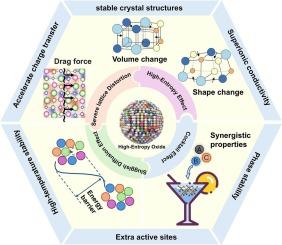高熵氧化物:下一代锂和钠离子电池电极的策略
IF 22
1区 材料科学
Q1 MATERIALS SCIENCE, MULTIDISCIPLINARY
引用次数: 0
摘要
对更高能量密度、更长的使用寿命和快速充电能力的需求不断增长,对下一代锂/钠离子电池中使用的电极材料提出了重大挑战。高熵氧化物(HEOs)的特点是将多个阳离子结合到单相结构中,在材料组成、稳定的晶体结构和独特的电子性能方面具有优异的灵活性。这些优点使heo成为创新活性电极材料或现有电极功能涂层的有希望的候选者。本文从基于构型熵、主元素数量或两者的清晰定义和分类开始,对电池应用中的heo进行了全面概述,为可重复性研究奠定了基础。还讨论了具有代表性的合成技术,因为它们影响颗粒尺寸,形貌,阳离子分布和缺陷结构,所有这些都直接影响电化学性能。此外,我们还探讨了在实际电池应用中由本征高熵效应驱动的结构-功能关系。此外,我们强调了关键的限制和挑战,包括稳定性问题、可扩展性和成本效益,同时概述了未来的研究方向,以弥合实验室成功和工业规模实施之间的差距。高熵策略可以实现原子级材料定制,为克服传统电极材料的局限性和推进下一代电池技术提供了一条途径。本文章由计算机程序翻译,如有差异,请以英文原文为准。

High-Entropy Oxides: A strategy for Next-Generation lithium and Sodium-Ion battery electrodes
The escalating demand for higher energy density, extended service life and fast-charging capability poses significant challenges to the presented electrode materials used in next-generation Li/Na-ion batteries. High-entropy oxides (HEOs), characterized by the incorporation of multiple cations into a single-phase structure, offer exceptional flexibility in material composition, stable crystal structure and unique electronic properties. These advantages position HEOs as promising candidates for both innovative active electrode materials or the functional coating layers for existing electrodes. This review provides a comprehensive overview of HEOs in battery applications, starting with a clear definition and classification based on configurational entropy, number of principal elements, or both, which lays the groundwork for reproducible research. Representative synthesis technologies are also discussed, as they influence particle size, morphology, cation distribution, and defect structures, all of which directly impact electrochemical performance. Furthermore, we explore the structure–function relationship driven by the intrinsic high-entropy effect in practical battery applications. Additionally, we highlight the key limitations and challenges, including stability issues, scalability, and cost-effectiveness, while outlining future research directions to bridge the gap between laboratory success and industrial-scale implementation. High-entropy strategies enable atomic-scale material customization, offering a pathway to overcome the limitations of conventional electrode materials and advance next-generation battery technologies.
求助全文
通过发布文献求助,成功后即可免费获取论文全文。
去求助
来源期刊

Materials Today
工程技术-材料科学:综合
CiteScore
36.30
自引率
1.20%
发文量
237
审稿时长
23 days
期刊介绍:
Materials Today is the leading journal in the Materials Today family, focusing on the latest and most impactful work in the materials science community. With a reputation for excellence in news and reviews, the journal has now expanded its coverage to include original research and aims to be at the forefront of the field.
We welcome comprehensive articles, short communications, and review articles from established leaders in the rapidly evolving fields of materials science and related disciplines. We strive to provide authors with rigorous peer review, fast publication, and maximum exposure for their work. While we only accept the most significant manuscripts, our speedy evaluation process ensures that there are no unnecessary publication delays.
 求助内容:
求助内容: 应助结果提醒方式:
应助结果提醒方式:


